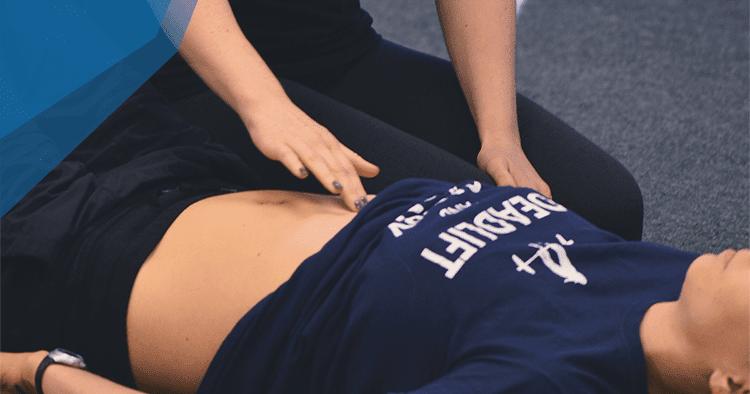When I finish explaining to women about abdominal separations, or diastasis recti, there's usually a look of shock and horror on their faces. "Will it ever go back together?" they ask with understandable worry.
Yes, it's possible, with consistent and focused effort, to heal diastasis recti (DR). But that's not actually the goal.
Let me explain.
What is diastasis recti?
We don't talk much about DR in the fitness industry. But we should. In fact, it should scream for your attention. That's because, as a trainer, you can easily make it worse. You may be doing it right now with your postpartum clients.
DR happens when the linea alba, the strip of connective tissue between the two sides of the rectus abdominis, becomes stretched and lax. It happens most often during pregnancy, as the growing fetus pushes against the abdominal wall, forcing the linea alba to widen in response.
We usually describe DR as separation of at least two finger-widths—2.7 centimeters, or a little more than an inch—although it can be several times as large. Worse than the width is the weakness and depth of the connective tissue. We're talking "push your fingers into the belly and feel a pulse" deep.
Here's why you should care:
Separated muscles and a lax linea alba give your postpartum client a weakened support system, leading to muscle strength imbalances, postural deficiencies, and a greater risk for any number of injuries, in or out of the gym.
If untreated, the client's chronically weak anterior core will force them to rely on other muscles (like the hip flexors) to stabilize their pelvis.
That's a recipe for low back pain, on top of the fact they'll continue to look five months pregnant well into their postpartum stage. And if you try to make progress in training before addressing the DR, your client may end up with an even bigger separation.
How to check for diastasis recti
First, I always recommend referring your prenatal and postnatal clients to a pelvic floor physiotherapist. The physio can ensure there aren't bigger issues going on (like a prolapsed uterus, rectum, or bladder), can assess the DR themselves, and can teach the client how to properly activate their abdominal and pelvic floor muscles.
It's easy to check for DR, and important to learn if you want to help your postpartum clients make progress in their training.
Step 1: Get client to lie down flat on the back, as if they were setting up for a glute bridge.
Step 2: Have them take a couple diaphragmatic breaths and totally relax the abdominals and glutes.
Step 3: Firmly press 2-3 fingers just above their belly button with the fingers and hand running vertically along the linea alba, fingertips facing towards the head.
Step 4: Get the client to tuck the chin towards the chest and slowly lift their head off floor until you feel the sides of the muscle bellies just start to pull together. Have them repeat this 2-3 times to get an accurate measurement. You may need to add or takeaway fingers (or hands) to get the appropriate width. Mark down how many fingers wide the IRD is.
Step 5: In this position, see how far into the belly you can press your fingers down. This will tell you how overstretched the connective tissue is. Take note if the connective tissue feels really shallow and taut or if you can press your fingers into the belly quite far.
Step 6: Repeat Steps 4 & 5, 1.5-2 inches above and below the belly button.
Step 7: Repeat the assessment at the belly button, below the belly button, and above the belly button. However, this time just before the client does their head lift they will take an exhale breath and do a gentle pelvic floor lift. Record if there are differences in the feeling of the connection tissue or in the IRD.
(Note: In a well functioning core, we want to feel good tension in the linea alba when the client does their head lift and pelvic floor lift. In a diastasis that still requires healing, you will feel the linea alba stay lax with the head lift and pelvic floor lift.)
How to fix Diastasis Recti, and more importantly, not worsen it?
There's specific exercise programming considerations regarding diastasis recti repair for your clients with DR. Here's what you need to emphasize:
1. Learning how to roll over again. If your client is going from a supine to seated position, teach them to roll to their side first, then push themselves up using upper body strength to seated. This will avoid unnecessary forward pressure on the DR.
2. Ribs Over Hips. This is one of my favourite cues that I've adopted from Julie Wiebe. You want your client to keep their ribcage over their pelvis during exercise, so the connective tissue is not continually overstretched. Refer to this video from Tony Gentilcore on teaching your clients to "own their rib position."
Note: Tony Gentilcore wrote a great blog on owning rib position that you can find it here: www.tonygentilcore.com/blog/simple-squat-fix-owning-rib-position/.
3. Retrain breathing patterns. During and after pregnancy you might notice a flaring of the ribcage and an inability to take full diaphragmatic breaths through the whole core. We need to retrain the diaphragm and ribcage to fully expand and contract, in ribs over hips position. We want the client to feel a gentle softening of their pelvic floor and abdominals on their inhale breath, and a gentle contraction of their pelvic floor and abdominals on their exhale breath. See this video from Mike Robertson on correcting faulty breathing patterns.
Note: Mike Robertson wrote a great blog on correcting breathing patterns. You can find it here: http://robertsontrainingsystems.com/blog/are-you-full-of-hot-air/.
4. Neutral everything. Your one goal when doing abdominal training will be to keep as much direct pressure off the DR as possible. Start training basic pelvic alignment, proper pelvic floor contraction and relaxation, heel slides, deadbug variations, side planking, and Pallof pressing.
5. Pelvis resetting. You might find your client is now in the habit of being in a posteriorly or anteriorly tilted pelvic position. We need to train them to feel what more neutral alignment feels like in standing, seated, and supine exercises and in daily life tasks.
Just Say No
To quote one of my clients who refuses to do anything that resembles moving quickly or using kettlebells, "Just say no" to anything where you're creating unmanaged internal abdominal pressure while treating the DR.
This means saying no to crunches, sit-ups, front loaded exercises (bird dogs, front planks, etc.), and any exercise where the client is forward flexed and can't create enough tension to hold the belly in (e.g., conventional deadlifts). No belly bulging, no bearing down.
The good news? You'll get to say yes to these things much sooner if you start the diastasis recti treatment immediately. Prenatal and postnatal training is one of the most under-served markets in our industry and these women deserve to be well taken care of by us, as coaches.
Extra Reading:
Tupler Technique: http://www.diastasisrehab.com/what-is-diastasis-recti.php
The Tummy Team: http://thetummyteam.com/physical-therapy/diastasis-recti/
Diane Lee: http://dianelee.ca/articles/DRA-InTouch.pdf










